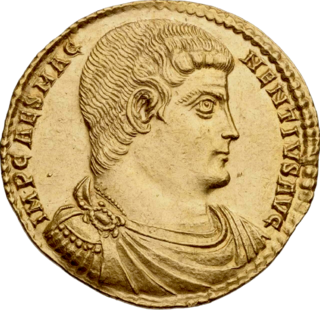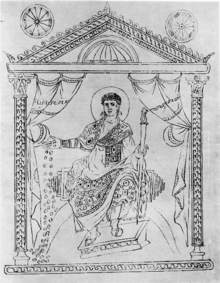Ammianus Marcellinus, occasionally anglicised as Ammian, was a Roman soldier and historian who wrote the penultimate major historical account surviving from antiquity. Written in Latin and known as the Res gestae, his work chronicled the history of Rome from the accession of the Emperor Nerva in 96 to the death of Valens at the Battle of Adrianople in 378. Only the sections covering the period 353 to 378 survive.

Constantius II was Roman emperor from 337 to 361. His reign saw constant warfare on the borders against the Sasanian Empire and Germanic peoples, while internally the Roman Empire went through repeated civil wars, court intrigues, and usurpations. His religious policies inflamed domestic conflicts that would continue after his death.

Julian was the Caesar of the West from 355 to 360 and Roman emperor from 361 to 363, as well as a notable philosopher and author in Greek. His rejection of Christianity, and his promotion of Neoplatonic Hellenism in its place, caused him to be remembered as Julian the Apostate in Christian tradition. He is sometimes referred to as Julian the Philosopher.

Valens was Roman emperor from 364 to 378. Following a largely unremarkable military career, he was named co-emperor by his elder brother Valentinian I, who gave him the eastern half of the Roman Empire to rule. In 378, Valens was defeated and killed at the Battle of Adrianople against the invading Goths, which astonished contemporaries and marked the beginning of barbarian encroachment into Roman territory.
The 350s decade ran from January 1, 350, to December 31, 359.

Valentinian I, sometimes called Valentinian the Great, was Roman emperor from 364 to 375. He ruled the Western half of the empire, while his brother Valens ruled the East. During his reign, he fought successfully against the Alamanni, Quadi, and Sarmatians, strengthening the border fortifications and conducting campaigns across the Rhine and Danube. His general Theodosius defeated a revolt in Africa and the Great Conspiracy, a coordinated assault on Roman Britain by Picts, Scoti, and Saxons. Valentinian founded the Valentinianic dynasty, with his sons Gratian and Valentinian II succeeding him in the western half of the empire.

Jovian was Roman emperor from June 363 to February 364. As part of the imperial bodyguard, he accompanied Julian on his campaign against the Sasanian Empire. Julian was killed in battle, and the exhausted and ill-provisioned army declared Jovian his successor. Unable to cross the Tigris, Jovian made peace with the Sasanids on humiliating terms. He spent the rest of his seven-month reign traveling back to Constantinople. After his arrival at Edessa, Jovian was petitioned by bishops over doctrinal issues concerning Christianity. Albeit the last emperor to rule the whole Empire during his entire reign, he died at Dadastana, never having reached the capital.

Magnus Magnentius was a Roman general and usurper against Constantius II. Of Germanic descent, Magnentius served with distinction in Gaul under the emperor Constans. On 18 January 350 Magnentius was acclaimed Augustus. Quickly killing the unpopular Constans, Magnentius gained control over most of the Western Empire. The Eastern emperor Constantius II, the brother of Constans, refused to acknowledge Magnentius' legitimacy and led a successful campaign against Magnentius. Ultimately, Magnentius' forces were scattered after the Battle of Mons Seleucus, and he died by suicide on 10 August 353.

This is a chronology of warfare between the Romans and various Germanic peoples. The nature of these wars varied through time between Roman conquest, Germanic uprisings, later Germanic invasions of the Western Roman Empire that started in the late second century BC, and more. The series of conflicts was one factor which led to the ultimate downfall of the Western Roman Empire in particular and ancient Rome in general in 476.
The Battle of Strasbourg also known as the Battle of Argentoratum was fought in 357 between the Western Roman army under Julian and the Alamanni tribal confederation led by the joint paramount King Chnodomar. The battle took place near Strasbourg, called Argentoratum in Ammianus Marcellinus' account, Argentorate in the Tabula Peutingeriana.
Silvanus was a Roman general and usurper of Frankish descent. He revolted in Gaul against Emperor Constantius II, claiming the imperial title for 28 days in AD 355.
The siege of Autun was a conflict fought between the Roman Empire and the invading barbarian Alamanni tribe, who were ravaging Gaul, in 356 AD. The Romans successfully defended the city, and the barbarians retreated on the approach of reinforcements.
Barbatio was a Roman general of the infantry under the command of Constantius II. Previously he was a commander of the household troops under Gallus Caesar, but he arrested Gallus under the instruction of Constantius, thereby ensuring his promotion on the death of Claudius Silvanus. In 359, both he and his wife Assyria were arrested and beheaded for treason against Constantius, possibly as part of a plot by Arbitio, a senior cavalry commander, and another exponent of the forms of scheming and political intrigue that became such a part of the later Roman Empire.
Macrian or Makrian was the king of the Bucinobantes, an Alemannic tribe, in the late fourth century and the brother of Hariobaudes. Macrian tried to confederate all the north Germanic and Alemannic tribes together against Rome.

Helena was a Roman Empress by marriage to Julian, Roman emperor in 360–363. She was briefly his Empress consort when Julian was proclaimed Augustus by his troops in 360. She died prior to the resolution of his conflict with Constantius II.
Chnodomar was the king of an Alamannic canton in what is now south-west Germany, near the Rhine from sometime before 352 till 357. He seems to have had a recognized position among the other Alamanni.
Flavius Arintheus was a Roman army officer who started his career in the middle ranks and rose to senior political and military positions. He served the emperors Constantius II, Julian, Jovian and Valens. In 372 he was appointed consul, alongside Domitius Modestus.
Dagalaifus was a Roman army officer of Germanic descent. A pagan, he served as consul in 366. In the year 361, he was appointed by Emperor Julian as comes domesticorum. He accompanied Julian on his march through Illyricum to quell what remained of the government of Constantius II that year. He led a party into Sirmium that arrested the commander of the resisting army, Lucillianus. In the spring of 363, Dagalaifus was part of Julian's ultimately-disastrous invasion of Persia. On June 26, while still campaigning, Julian was killed in a skirmish. Dagalaifus, who had been with the rear guard, played an important role in the election of the next emperor. The council of military officers finally agreed on the new comes domesticorum, Jovian, to succeed Julian. Jovian was a Christian whose father Varronianus had himself once served as comes domesticorum.
Gundomad or Gundomar, was an Alemannic petty king in the area around Breisgau, Germany in the 4th century. The Roman historian Ammianus Marcellinus reports that Gundomad, together with his brother Vadomarius, in 354 concluded a peace treaty at Augst after having been defeated in battle by emperor Constantius II. In 357, Gundomad was killed by his own people for having been to loyal to the Romans. They then made an uprising against emperor Julian.
Vithicabius was an Alemannic petty king from 360 to 368. He was a son of Vadomarius, and succeeded his father as king after the latter had been banished to Hispania by emperor Julian. He had grown up in Roman custody. Ammianus Marcellinus describes Vithicabius as a physically weak, but a brave and aggressive leader. Although having promised Julian to maintain peace, Vithicabius continued raiding Roman territory. He was assassinated in 368 under Valentinian I by a bribed servant, but the Alemannic raids on Roman territory continued nevertheless.









